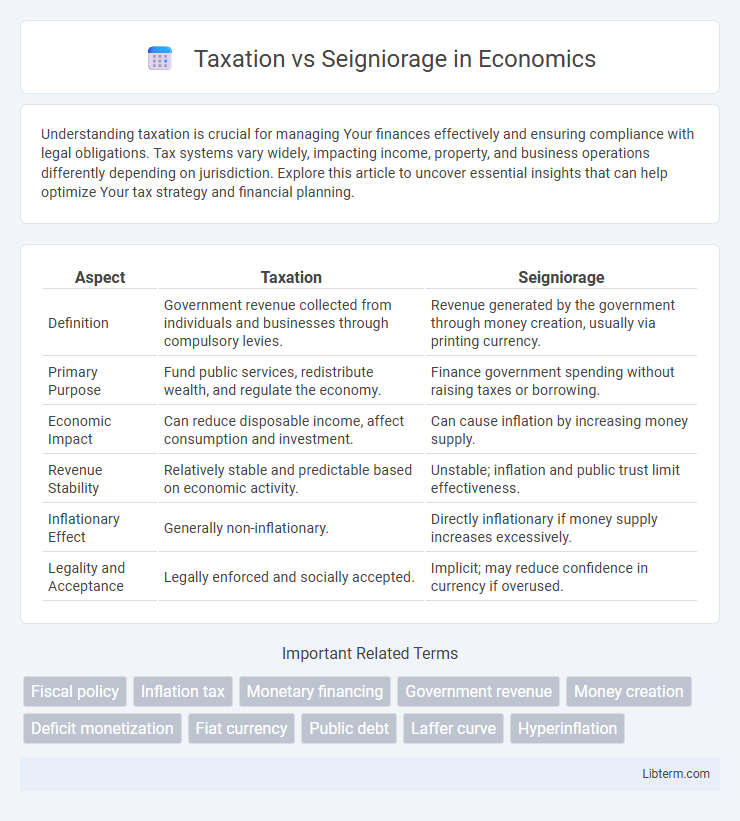Understanding taxation is crucial for managing Your finances effectively and ensuring compliance with legal obligations. Tax systems vary widely, impacting income, property, and business operations differently depending on jurisdiction. Explore this article to uncover essential insights that can help optimize Your tax strategy and financial planning.
Table of Comparison
| Aspect | Taxation | Seigniorage |
|---|---|---|
| Definition | Government revenue collected from individuals and businesses through compulsory levies. | Revenue generated by the government through money creation, usually via printing currency. |
| Primary Purpose | Fund public services, redistribute wealth, and regulate the economy. | Finance government spending without raising taxes or borrowing. |
| Economic Impact | Can reduce disposable income, affect consumption and investment. | Can cause inflation by increasing money supply. |
| Revenue Stability | Relatively stable and predictable based on economic activity. | Unstable; inflation and public trust limit effectiveness. |
| Inflationary Effect | Generally non-inflationary. | Directly inflationary if money supply increases excessively. |
| Legality and Acceptance | Legally enforced and socially accepted. | Implicit; may reduce confidence in currency if overused. |
Introduction to Taxation and Seigniorage
Taxation refers to the compulsory financial charges imposed by governments on individuals and businesses to fund public services and infrastructure, playing a crucial role in fiscal policy. Seigniorage is the revenue generated from issuing currency, representing the difference between the face value of money and the cost to produce it, often considered a form of inflation tax. Understanding the distinction between taxation and seigniorage is essential for analyzing government revenue sources and their impact on economic stability.
Defining Taxation: Mechanisms and Purpose
Taxation involves compulsory financial charges imposed by governments on individuals and businesses to fund public expenditures and redistribute wealth. It operates through mechanisms like income tax, sales tax, and property tax, designed to generate steady revenue without directly increasing the money supply. The primary purpose of taxation is to provide resources for public services, infrastructure, and social programs while maintaining economic stability.
Understanding Seigniorage: Creation of Money as Revenue
Seigniorage refers to the profit generated by a government when it creates new money, which can be used as a source of revenue without raising taxes. Unlike taxation that collects existing real resources, seigniorage effectively increases the money supply, potentially leading to inflation if overused. Understanding seigniorage involves recognizing its dual role as monetary financing and its impact on economic stability and inflationary pressures.
Historical Context: Taxation vs Seigniorage
Taxation has historically served as the primary method for governments to generate revenue, dating back to ancient civilizations where levies on land, goods, and labor were essential for maintaining state functions. Seigniorage, the profit made from issuing currency, played a complementary role especially in periods of economic stress or wartime when coinage debasement or paper money issuance increased government funds without direct taxation. The Roman Empire and medieval European states provide key historical examples where seigniorage was used as an alternative or supplement to taxation, highlighting its influence on monetary policy and inflation.
Economic Implications of Taxation
Taxation directly influences income distribution and resource allocation by reducing individual and corporate spending power, which can lead to decreased consumption and investment. It serves as a tool for correcting market failures and funding public goods but may also create distortions that affect labor supply and productivity. Compared to seigniorage, which generates revenue through money creation and can induce inflation, taxation provides a more stable and predictable source of government funding with clearer economic signals.
Inflationary Effects of Seigniorage
Seigniorage generates revenue for governments by printing money, which directly increases the money supply and leads to inflationary pressures as more currency chases the same amount of goods and services. Unlike taxation, which transfers existing purchasing power from the private sector to the public sector, seigniorage creates new money and can erode the real value of savings and fixed incomes. High reliance on seigniorage often results in hyperinflation, destabilizing the economy and reducing economic growth prospects.
Revenue Generation: Efficiency and Limitations
Taxation generates government revenue through direct financial contributions from individuals and businesses, providing a stable and predictable income stream but often incurring administrative costs and economic distortions. Seigniorage produces revenue by issuing currency beyond the economy's demand, effectively allowing governments to finance expenditures through money creation, though this can induce inflationary pressures and erode purchasing power. Efficiency in taxation depends on minimizing deadweight losses and compliance costs, while seigniorage's limitations arise from its inflationary impact, making it a less sustainable long-term revenue source.
Social Equity: Distributional Consequences
Taxation directly redistributes wealth by imposing progressive rates on income and consumption, which can reduce income inequality and fund public services that benefit lower-income groups. Seigniorage, generated through money creation by the central bank, may indirectly affect social equity by fueling inflation, which disproportionately harms low-income households with less financial resilience. Understanding the distributional consequences of both mechanisms is critical for designing fiscal and monetary policies that promote social equity and economic stability.
Policy Choices: Balancing Taxation and Seigniorage
Policymakers face challenges in balancing taxation and seigniorage as revenue sources, with excessive reliance on seigniorage risking inflationary pressures that undermine economic stability. Optimal fiscal strategy involves calibrating tax rates to generate sustainable revenue while using controlled seigniorage to finance government spending without eroding currency value. Empirical studies indicate that moderate seigniorage coupled with efficient tax collection improves fiscal resilience and supports long-term economic growth.
Future Trends in Government Financing
Government financing is increasingly leveraging seigniorage as digital currencies and blockchain technologies reduce transaction costs and enhance monetary control. Taxation remains essential for revenue but may see declining reliance as automated monetary issuance provides a more flexible and immediate funding source. Future trends suggest a hybrid model where central banks and governments balance inflation risks with efficient resource mobilization through innovative seigniorage mechanisms.
Taxation Infographic

 libterm.com
libterm.com